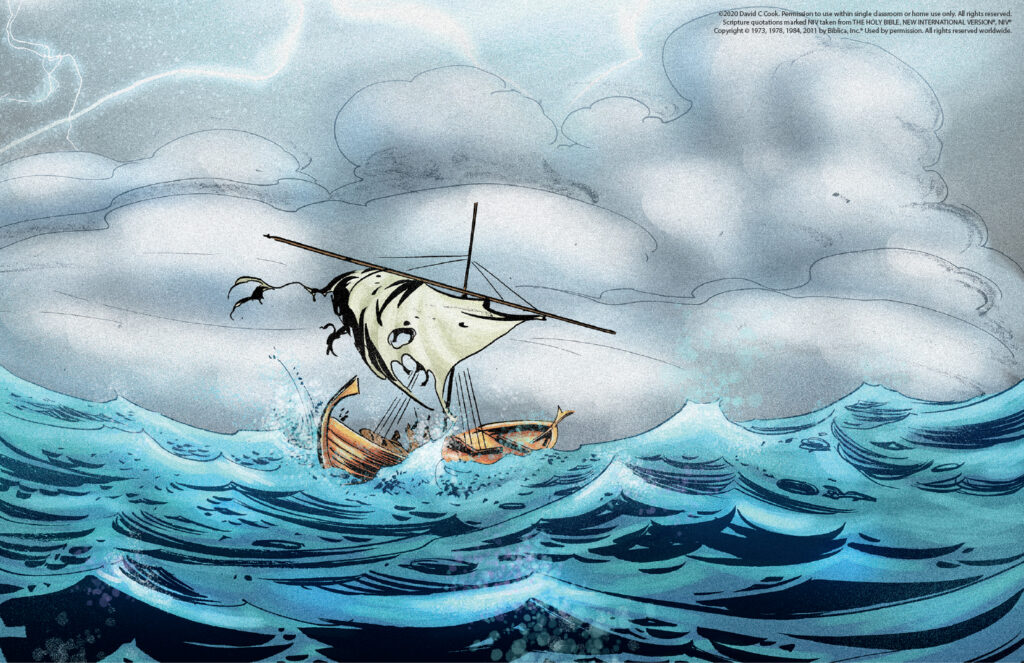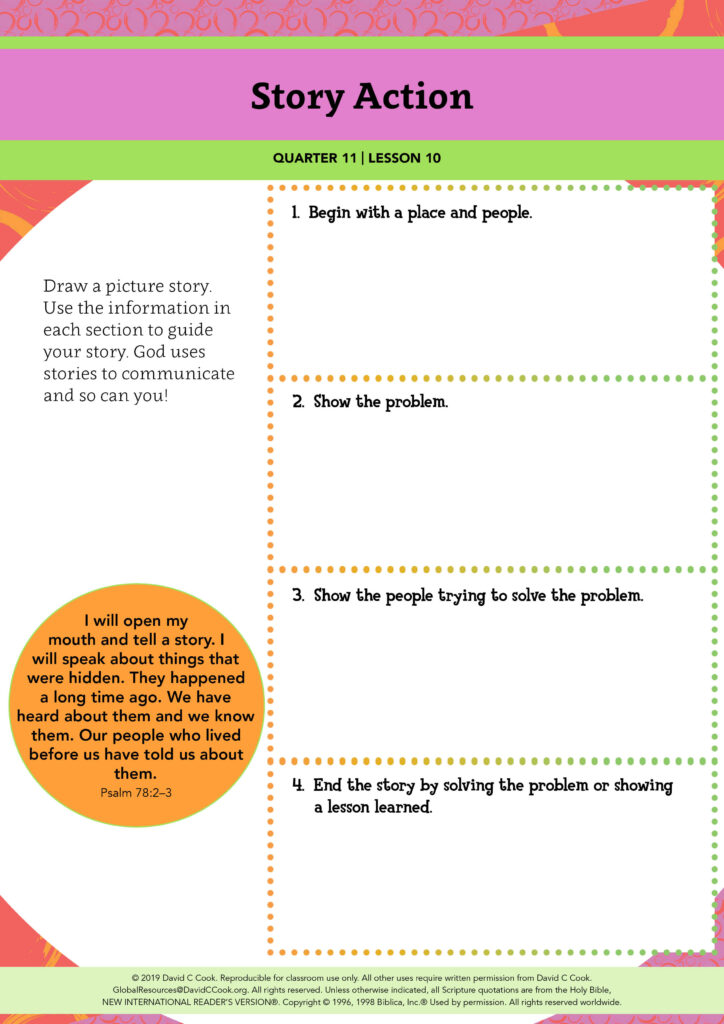During the lesson, the information for you to know is written in regular type, and what we suggest speaking or reading aloud to children is in bold. All resources for this lesson, including the Teacher Guide, Student Page, Family Connection Card, and other resources can be downloaded in a ZIP file by clicking on the following link:
In some lessons you will find "resource articles." These are articles written by experts from around the world to help equip you for your work with children and adolescents. Share them with parents or guardians if you consider it appropriate.
*If you are using paper or cardboard, have the story drawings from the previous lesson available for the children who return to class this week. If you use the optional image from The Action Bible, save it to use again in Lesson 12.
Before the children arrive, review the story you began drawing for Lesson 9. You will use your story as your example for this lesson. Add to your story the elements outlined below. If you do not have a beginning to your story, you will need to fold a paper or piece of cardboard into 4 sections. Each number below corresponds with a box on your paper. Draw pictures in the following order to show your story.
I will open my mouth and tell a story. I will speak about things that were hidden. They happened a long time ago. We have heard about them and we know them. Our people who lived before us have told us about them.
Psalm 78:2–3
We tell stories for many purposes. Stories help us to connect with others and share our experiences, but the most important stories are shared many times with many people so that they will be remembered. The most important story of all, the Bible, is told through many smaller stories that help us to learn what it means to know and worship God and to live in ways that are pleasing to Him.
Your story is part of God’s great story. Think about things that have happened to you that you have shared with others. What impact is your story having on the lives of those around you and their relationships with God? You may not know the answer to this question. One thing is for sure, God intended for you and me to use stories to help others understand us and understand who He is.
Encourage families to tell stories from their own childhoods to their children. This could mean telling stories they heard as children or stories about things that they experienced as children.
Teacher Tip: If possible, email or text the Family Connection Card to the families of your students.
Greet the children as they come to class. Ask each child to think of her favourite story and find a partner to share it with. Then ask the children to sit in a circle.
The last time we met, we talked about the details we need to begin a story. Raise your hand if you remember 1 thing we need to begin a story.
Call on 3–4 children and have each name an element needed to begin a story. If they do not mention the following, remind the children of these elements: characters, a place, and an event that leads to a journey.
In a moment, you will hear the story of the apostle Paul’s shipwreck. I will ask you to listen for the things you just named at the beginning of the story. Then, I will tell the rest of the story. This is the true story from the Bible of Paul’s shipwreck.
As we heard last time, Paul was put on trial because the Jewish leaders said he did wrong things. He told a Roman king he had done nothing wrong but he wanted to bring his case to Caesar—the ruler of the whole Roman empire.
Paul was sent to Rome on a ship with other prisoners. A Roman commander named Julius led the other soldiers on the ship.
Great! These pieces come together to make the beginning of our true story from the Bible. Would you like to hear the rest of the story? Listen carefully.
Optional: If possible, share the image from The Action Bible.

While the men were sailing, they had a problem! A little while into the journey, Paul warned that the trip would be dangerous. The Roman commander did not listen to Paul. The men continued to sail and got caught in a storm! This is what happened next:
If possible, read this verse directly from your Bible.
The ship was caught by the storm. We could not keep it sailing into the wind. So we gave up and were driven along by the wind.
Acts 27:15
The crew could not control the ship. The wind was very strong!
What is the problem in the story?
There was a storm that put the men’s lives in danger. They could not control the ship.
Do you want to hear how the men tried to deal with their problem? As I tell you a way the men tried to solve the problem, you will say, “We hope this stops the ship.”
Say, “The men tried.” Have the students respond, “We hope this stops the ship” after each thing the men tried to do to help. Then respond, “But this did not stop the ship!”
The storm continued for many days. Paul and the other people on the ship were in great danger. That is when Paul told everyone about a message he received from God. Listen to what Paul told the men on the ship.
I belong to God and serve him. Last night his angel stood beside me. The angel said, “Do not be afraid, Paul. You must go on trial in front of Caesar. God has shown his grace by sparing the lives of all those sailing with you.” Men, continue to be brave. I have faith in God.
It will happen just as he told me.
Acts 27:23–25
God always keeps His promises. The ship crashed beside the island of Malta, but just as God had promised Paul, all of the men on the ship reached land safely.
What was the solution to the problem in this story?
The ship crashed, and the men escaped to an island.
Not every story has a solution. Sometimes a character in a story learns a lesson from a difficult situation, but the difficulty continues. Other times, the people in a story may not get where they wanted to go, but the journey changes them in some way. In Paul’s story, he does eventually go to Rome. However the break in his journey leads to a valuable lesson. The people on the ship learn that God is full of grace and He keeps His promises.
Let’s talk more about the story of Paul’s shipwreck.
What happened to make the story exciting?
Allow 1–2 children to respond.
There was a storm! This was a problem in the story because the men lost control of the ship. When we have problems in our lives, we often try to solve them by ourselves.
What did the men do to try to solve their problem?
They threw things off the ship. They tried to stop the ship.
In stories, we often hear about people trying to solve their problems. Sometimes those are good ways to solve our problems. But sometimes, like in Paul’s story, we cannot solve our own problems.
Who solved the problem in Paul’s story?
God solved the problem.
God was with Paul throughout this story. Most stories end with a lesson or with the people in the story changing in some way. In Paul’s story, the men reached land safely. They survived the big storm!
Give the children the papers they drew on the last time they came to class. Give the children who did not attend the class a blank paper or piece of cardboard that has been pre-folded into 4 sections. If you are using an area of dirt for children to draw on, have the children draw 4 boxes.
Optional: If you are using Student Pages, you may have children use the pages instead of a blank paper. Be sure to collect these and keep them for the next lesson.

Think about the characters, place, and lesson or goal you created the last time we met. If you did not create these, you may take a moment to draw a picture of the people in your story and the place where the story will begin.
Have the children who did not draw characters and places spend this time drawing these elements. Have the children who already have story beginnings sit in pairs, and allow 2–3 minutes for the children to share and work.
Now that everyone has a beginning to your stories, let’s spend some time creating the action for your stories. Think about what problem or problems your characters might face as they go on their journey.
Show the children the story you drew before class. Explain to the children what problem you chose for the characters in your story. Then ask the children to think about problems in their own lives or problems they think their characters might face. Give them 30 seconds to think about problems they can use to tell their own stories.
In the second section of your paper, draw your characters experiencing a problem. If your characters will have more than 1 problem to solve, only draw the biggest problem they will have.
Give the children 2–3 minutes to draw.
Now that you have a problem for your story, let’s think about how our characters will try to solve their problems.
Show the children how the characters in your story will try to solve their problem. Then give the children 30 seconds to think about how their characters will solve their problems.
In the third section on your paper, draw your characters trying to solve their problem. As you draw, think about what they will do and where they need to be to solve the problem.
Give the children 2–3 minutes to draw.
Finally, your story will need an ending. There are many ways to end a story. Here are some examples of ways to end stories:
Think about how you would like your story to end. Then, in the last box, draw the end of your story.
Give the children 2–3 minutes to finish their stories. After all of the children have finished, write or have the students write their names on their papers. Collect the papers and save them for the next lesson.
The greatest story ever told is found in the Bible. The Bible is 1 big story told through many smaller stories. Our memory verse today tells us stories can help us remember things that have happened in the past.
If you are using the Memory Verse Poster, show it to the students.
The heavens tell about the glory of God. The skies show that his hands created them.
Psalm 19:1

Say this verse with expression. Have the children repeat this with you 3 times. End class by saying this blessing, based on Psalm 78:2–3, over the children.
Blessing: May you learn to tell stories for many purposes. May you trust God in His wisdom to help you to know how and when to share your stories.
Lead the children in singing this quarter’s song, if possible.
Life on Life ©2020 David C Cook. Reproducible for home or classroom use only. All other uses require written permission from David C Cook [email protected]. All rights reserved.